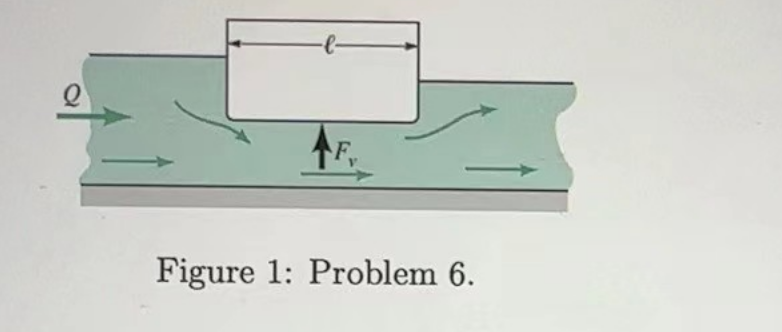6. Water flowing under the obstacle shown in Fig. 1 puts a vertical force F, on the obstacle. This force is assumed to be a function of the volumetric flowrate Q, the water density p, the gravitational acceleration g, and a length & that characterizes the size of the obstacle. A 1/20 scale model is to be used to predict the vertical force on the prototype. (b) Perform a dimensional analysis for this problem. If the prototype flowrate is 100 m³/s, determine the water flowrate
6. Water flowing under the obstacle shown in Fig. 1 puts a vertical force F, on the obstacle. This force is assumed to be a function of the volumetric flowrate Q, the water density p, the gravitational acceleration g, and a length & that characterizes the size of the obstacle. A 1/20 scale model is to be used to predict the vertical force on the prototype. (b) Perform a dimensional analysis for this problem. If the prototype flowrate is 100 m³/s, determine the water flowrate
Refrigeration and Air Conditioning Technology (MindTap Course List)
8th Edition
ISBN:9781305578296
Author:John Tomczyk, Eugene Silberstein, Bill Whitman, Bill Johnson
Publisher:John Tomczyk, Eugene Silberstein, Bill Whitman, Bill Johnson
Chapter40: Typical Operating Conditions
Section: Chapter Questions
Problem 10RQ: The seasonal energy efficiency ratio (SEER) includes the energy used in the _____and _____cycles.
Related questions
Question
100%

Transcribed Image Text:F₂
Figure 1: Problem 6.

Transcribed Image Text:6. Water flowing under the obstacle shown in Fig. 1 puts a vertical force F, on
the obstacle. This force is assumed to be a function of the volumetric flowrate
Q, the water density p, the gravitational acceleration g, and a length that
characterizes the size of the obstacle. A 1/20 scale model is to be used to
predict the vertical force on the prototype.
Perform a dimensional analysis for this problem.
-If the prototype flowrate is 100 m³/s, determine the water flowrate
for the model if the flows are to be similar.
(a)
(b)
Expert Solution
This question has been solved!
Explore an expertly crafted, step-by-step solution for a thorough understanding of key concepts.
Step by step
Solved in 4 steps with 18 images

Knowledge Booster
Learn more about
Need a deep-dive on the concept behind this application? Look no further. Learn more about this topic, mechanical-engineering and related others by exploring similar questions and additional content below.Recommended textbooks for you

Refrigeration and Air Conditioning Technology (Mi…
Mechanical Engineering
ISBN:
9781305578296
Author:
John Tomczyk, Eugene Silberstein, Bill Whitman, Bill Johnson
Publisher:
Cengage Learning

Principles of Heat Transfer (Activate Learning wi…
Mechanical Engineering
ISBN:
9781305387102
Author:
Kreith, Frank; Manglik, Raj M.
Publisher:
Cengage Learning

Refrigeration and Air Conditioning Technology (Mi…
Mechanical Engineering
ISBN:
9781305578296
Author:
John Tomczyk, Eugene Silberstein, Bill Whitman, Bill Johnson
Publisher:
Cengage Learning

Principles of Heat Transfer (Activate Learning wi…
Mechanical Engineering
ISBN:
9781305387102
Author:
Kreith, Frank; Manglik, Raj M.
Publisher:
Cengage Learning